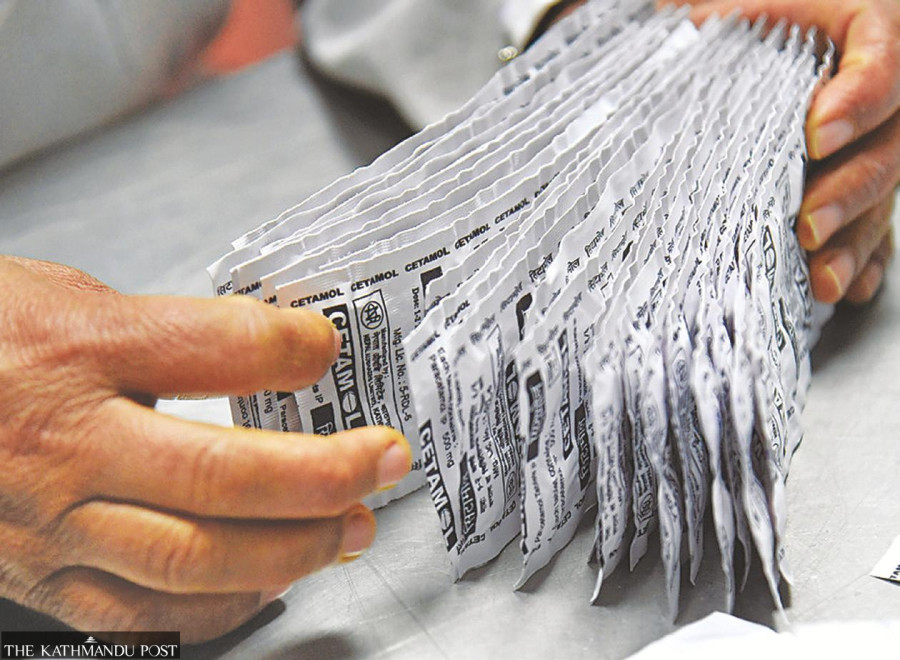Health
Stagnant paracetamol price contributing to its shortage
The medicine’s pricing, not revised for 14 years, seems to be a big reason for the shortfall.
Arjun Poudel
On Wednesday, Kul Prasad Bhattarai, a resident of Kuleshwar in Kathmandu Metropolitan City-14, visited numerous pharmacies in his area looking for paracetamol, as he suffered from severe body ache due to dengue infection.
He, however, could not find the medicine in any of the drug stores.
“I sent my children to different places to search for the medicine but they returned without a single tablet,” said Bhattarai, 74, who was infected with the dengue virus nine days ago. “My wife too has been infected and has severe body ache but we can’t even get the paracetamol.”
This is a problem faced by hundreds of patients infected with dengue, a disease that has seen an alarming spread of late, infecting around 20,000 and killing around two dozen people across the country.
Paracetamol, or acetaminophen, is a drug used worldwide to relieve pain and reduce fever.
It is used to treat many conditions—including headache, muscle ache, arthritis, backache, toothache, sore throat, menstrual pain, musculoskeletal pain, cold and fever.
Nepal government has listed paracetamol as an essential drug and provides it free of cost from state-run health facilities across the country. The drug is available in the market under different brand names, with Cetamol, manufactured by the state-owned Nepal Drug Limited, the most commonly available brand.
Paracetamol is the only medicine prescribed by physicians as safe for dengue patients.
With the massive spread of dengue throughout the country, demand for paracetamol increased several fold. This caused a crisis in the market, forcing patients to use non-steroidal anti-inflammatory drugs (NSAIDs) to relieve pain.
Doctors warn that the use of the NSAIDs increases the risk of internal bleeding, including in the eyes, and elevates liver enzymes, damaging the organ.
“A lot of patients complain about the shortage of paracetamol in the market,” said Dr Sher Bahadur Pun, chief of the Clinical Research Unit at Sukraraj Tropical and Infectious Disease Hospital. “Patients have been taking non-steroidal anti-inflammatory drugs—Flexon tablets, Nims, and Rynex, among others—to cure body ache caused by the dengue infection. Using such drugs is very risky in dengue infection.”
Some patients who use NSAIDs in excess also suffer internal bleeding. Such patients need to transfuse platelet-rich plasma and platelet concentrate, doctors say.
Officials at the Department of Drug Administration, the national regulatory body of pharmaceutical products, said the paracetamol crisis is a result of its high demand caused by soaring dengue cases and people’s tendency to hoard the medicine at home.
“We have deployed pharmacy inspectors to drug factories that produce paracetamol to increase the production from today [Thursday],” said Santosh KC, spokesperson for the department.
“We have also requested drug manufacturing companies to ramp up production by importing more raw materials.”
Paracetamol was also in short supply during the first and second waves of the Covid-19 pandemic.
Experts say the authorities’ indifference to increase the price of the medicine is the main reason for the crisis. Paracetamol is among the 96 medicines whose prices were determined by the department some 14 years ago.
The price of a 500mg paracetamol tablet was set at Re1, which remains unchanged. The exchange rate to the US dollar that is required to purchase raw materials from abroad was less than half at the time compared to the present. Price of a kg of raw material, which was around $2 at the time, has increased four fold. Per litre price of diesel was Rs58 at the time and labour cost has also increased, complained drug manufacturers.
“We are forced to sell the medicine at Re1 while the manufacturing cost exceeds the price,” said Deepak Dahal, former president of the Association of Pharmaceuticals Producers of Nepal.
“Dirty political games are being played over paracetamol and the authorities seem indifferent to the problem, even when patients have had to search the entire city for a single file of paracetamol.”
Nepal needs around 100 million tablets of paracetamol each year. The association said that drug manufacturers produced and supplied 30 million doses to the market in the past two months. Medicines sent to the districts outside Kathmandu are also being withdrawn to address the growing demand in the Valley but even that hasn’t solved the crisis, Dahal said.
As the government has not increased the price of paracetamol, Indian drug manufacturers are not exporting the drug to Nepal. Nepal imports over 60 percent of the drugs consumed in the country from India. Meanwhile, private pharmaceutical companies in Nepal also do not produce drugs in sufficient quantities to avoid losses, officials at the Health Ministry said.
“We have reached an understanding with drug manufacturers to increase the price of paracetamol and other essential drugs whose prices were fixed years ago and have not been revised since,” Bharat Bhattarai, director general at the Department of Drug Administration, said. “I hope the paracetamol crisis will be resolved in the next couple of days.”




 21.12°C Kathmandu
21.12°C Kathmandu














